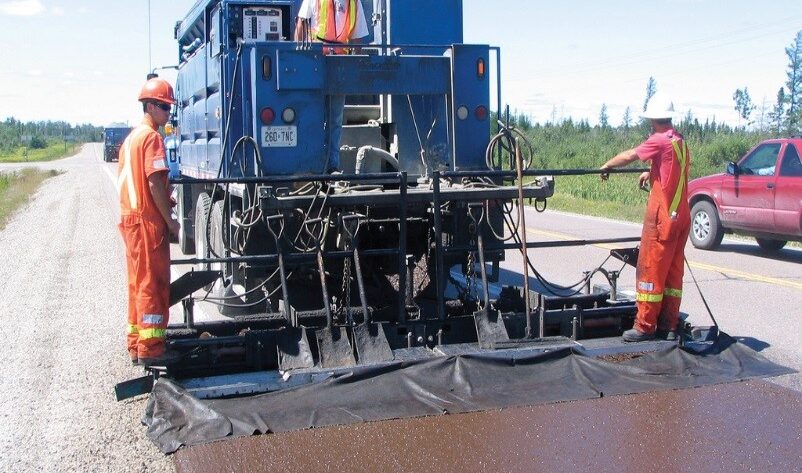To mitigate runway/taxiway and apron wear caused by heavy use and climate conditions on these long stretches of asphalt, effective regular maintenance is the key to keeping runways safe. Therefore, finding the right pavement treatment process is essential. Below are two (2) options:
P-626 Emulsified Asphalt Slurry Seal Surface Treatment
P-626 is the Federal Aviation Administration (FAA) specification for slurry seal surface treatments. A slurry seal is a homogenous mixture of emulsified asphalt, water, well-graded fine aggregate, and mineral filler that has a creamy, fluid-like appearance when applied. Slurry seals are used to fill existing pavement surface defects, as a preparatory treatment for other maintenance treatments such as bituminous paving overlays, or as a wearing course.
Surface Preparation
- Prior to applying the slurry seal; loose material, oil spots, vegetation, and other objectionable material shall be removed.
- Tack coat is usually required prior to applying the slurry seal If the surface to be covered is extremely dry and raveled or if it is concrete or brick
- It is recommended to treat cracks wider than 0.25” in the pavement surface with an approved crack sealer prior to application of the slurry seal.
How Slurry Coats are Applied
Slurry seals are applied using a special truck that contains various compartments holding the aggregate, water, polymer modified emulsion, and other additives, which are mixed in the on-board mixer. The slurry mixture then flows out of a dispensing system mounted on the rear of the truck and onto the pavement within the confines of a spreader box. The box serves to distribute the slurry mixture over the pavement. Workers with squeegees follow behind, assisting in spreading the mixture, correcting areas not properly covered, and keeping the mixture off areas where the slurry is not intended to be applied.
How Do Slurry Coats Work
The slurry substance provides a new surface course and replaces the fines in the existing surface that have deteriorated over time. It fills minor cracks and restores a skid resistant surface. When applied, slurry seal will have a brownish color due to its ingredients. The slurry behaves like a viscous liquid, which makes it easy to spread across the entire application area. After it is smoothed out, the area is left to cure for at least 24 hours before it is available for use.
Pros:
- Can be a long-term solution (5-8 years life expectancy)
- Cost effective ($0.76 per square foot)
- Restores skid resistance
- Protects the underlying pavement from aging and the environment
Cons:
- Can peel or delaminate if not properly applied
- Can cause issues with rapid tire wear
- Can only be applied during warm weather
- Severe Foreign Object Debris (FOD) can occur if underlying surface is not properly prepared to receive the treatment.
P-608 Emulsified Asphalt Seal Coat
P-608 is the Federal Aviation Administration (FAA) specification for a specialized type of Emulsified Asphalt Seal Coat. Sealcoating is the process of applying a protective coating to asphalt-based pavements to provide a layer of protection from the elements: (water, oils, and U.V. damage.) the most commonly used Emulsified Asphalt Seal Coating is GSB-88 (gilsonite sealer-binder emulsion). GSB-88 uses an emulsified asphalt that contains 20% Gilsonite and a medium to fine graded sand. The Gilsonite additive and the use of more finely graded aggregate differentiate it from more conventional Seal Coats.
Surface preparation
- Repair any cracks, potholes and other damages prior to applying seal coat.
- Make sure to clean off any leaked automotive fluid from the pavement, power wash pavement or use an air broom or a wire brush to ensure that the pavement is thoroughly cleaned.
- The pavement should be completely dry before the sealant is applied.
How is it Seal Coating Applied?
Being of low viscosity, Seal Coating is typically sprayed using application equipment that can apply the required coverage rates evenly over the pavement surface. A truck equipped with spray units and a pumping/distribution system using positive displacement pumps is commonly used.
How Does Seal Coating Work?
Seal coating rejuvenates asphalt pavements by reintroducing oils and resins, that have been lost through oxidation and use, into the asphalt binder between aggregates. It is formulated to cure quickly and designed to penetrate the asphalt and rebind the aggregate, sealing out and protecting the pavement from the harmful effects of water and oxidation.
Pros:
- Economical (0.25$ per square foot)
- Can be applied on grooved runways
- Fast cure
- Can be fuel resistant
- Protects from U.V. radiation and oxidation
- Provide aesthetic black surface
- Testing is minimally destructive compared to other treatments
Cons:
- Can wear faster in high traffic areas
- Can only be applied during warm weather
- Life expectancy is 2-3 years
- Once it wears off, the pavement will begin to deteriorate at the same rate as prior to application
- Frequent reapplication can be detrimental to grooved pavement
Tagged In:
Airport Engineering & Planning
